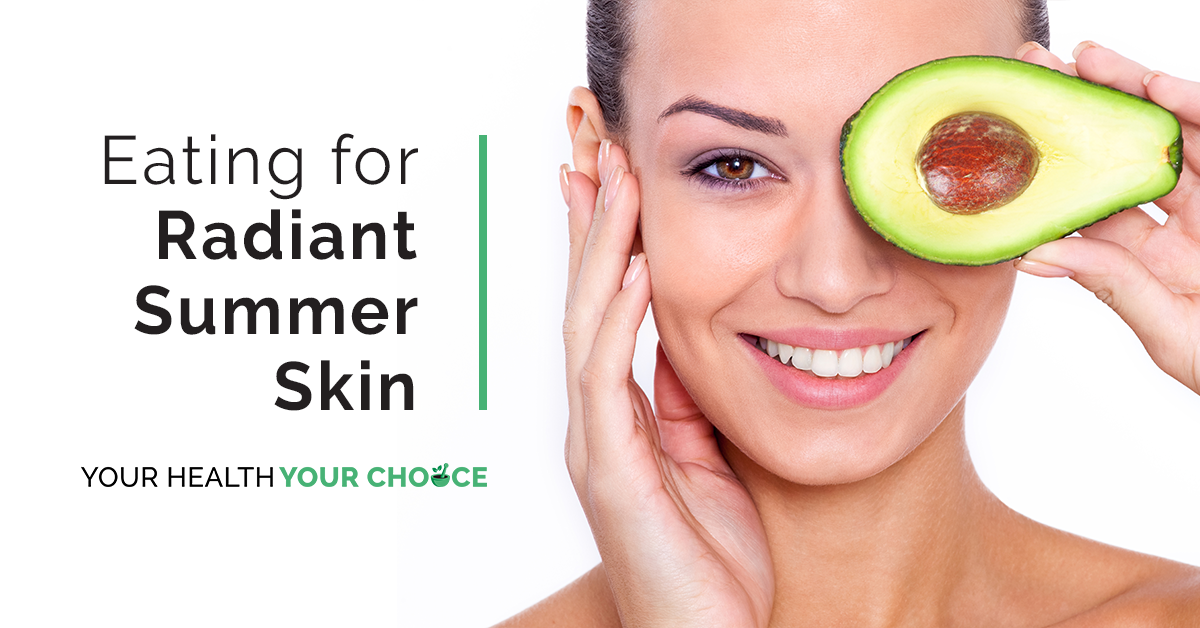Eating for radiant summer skin

Coming into summer it is time to bare a bit more skin. How does your skin look after a long hard winter?
Truly healthy and glowing skin depends on our inner health – proper gut function, relaxed nervous system, and adequate elimination of wastes. What you are eating can make all the difference to how your skin looks, feels, and functions.
Stressed out skin
Environment can wreak havoc on your skin also. Post-winter skin can often appear dull, pale and dehydrated after many months of heating, little sunshine, windburn, and not as much fresh seasonal produce or exercise. UV damage from the sun, pollution, and heat stress can also ruin our complexions. Red, ruddy complexions and dark under-eye circles can also be a sign of stress and inflammation.
Perhaps you have just gone through a stressful period and your skin is showing signs of wear and tear. Too many stress hormones and loss of sleep are also key contenders for poor skin function and appearance.
Does diet matter?
Very much so!
Research has shown that a low Glycaemic Index (GI) diet can help reduce the symptoms of acne and improve the quality of your skin. This basically means eating more wholegrains (if tolerated) and legumes and cutting out dairy and refined and processed foods (which challenge the immune system to overreact). This diet has a two-fold effect as it is great for your digestive health as well as reducing inflammation in the skin and blocked pores.
Wholegrains such as brown rice, millet, whole oats, and quinoa also provide the antioxidant mineral selenium and good levels of several other vitamins and minerals that play roles in the growth of healthy skin, hair and nails. Legumes will increase fibre to ensure proper elimination of waste from the body. Sluggish elimination really shows on our skin when toxins are recirculated through our systems.
Inflammatory foods, deficiency in essential nutrients, dehydration, and allergic reactions can all contribute to redness, rashes, and broken capillaries.
Hydration must not be overlooked, with experts recommending 8-10 glasses of pure water daily.
Our favourite skin foods
Luckily, making a few simple tweaks to your grocery list can help feed our skin from within and benefitting all aspects of our health. We have listed some wonderful skin loving foods:
DARK GREEN LEAFY VEG:
This is numero uno for high-powered age defence. The darker the green the better due to higher levels of antioxidants. These fight the free radicals that damage cells and accelerate aging of the skin. One of these antioxidants beta-carotene can also form vitamin A in the body and protect skin from UV damage.
Eat leafy greens daily and watch your skin begin to glow. Spinach, silver beet, kale, rocket, watercress, and Asian greens are fantastic. Greens are chock-full of vitamins A and K, which are essential in protecting your skin against free-radical damage and premature lines and wrinkles. Vitamin K is also known to help perk up the sensitive eye area and address dark circles.
AVOCADO:
Perfect in summer as it is rich in the essential fats which we depend on to nourish our skin and hair and a great source of vitamin E to help protect the skin from free radicals and sun damage. Good fats help to produce elastin (which keeps skin flexible) and moisturised.
NUTS AND SEEDS:
Providing all the right kinds of fat that nourish our skin. They are also rich in the antioxidant vitamin E to combat free radical damage, which contributes to the ageing of your skin. Walnuts, chia seeds and hemp seeds contain essential fatty acids such as omega-3, important for reducing inflammation and protecting and reinforcing the skin’s barrier.
Sunflower seeds combat hormone-induced conditions such as skin dryness and hyperpigmentation. Brazil nuts have high levels of selenium, nature’s detoxifier plus major antioxidant. Research has shown that selenium helps improve acne.
BERRIES:
High in capillary-protective vitamin C and acne-fighting antioxidants, berries are the queens of anti-aging. Berries can help balance and normalize oil levels in the skin, resulting in less congestion and sebum build-up. Good for broken capillaries which can cause blotchiness and spider veins. The vitamin C levels in blueberries help strengthen blood vessels, making them less likely to break.
Berries are also rich in folic acid which helps regenerate new cells, combating wrinkles and fine lines. Kiwi fruit is also very high in vitamin C – essential to make the protein collagen, which gives skin its youthful elasticity, maintain hydration and prevent wrinkles.
CARROTS:
Medicine for acne, sallowness, and aging, sagging skin. Carrots are one of the richest sources of carotenoids (sweet potato also a contender) and are known to lend pale or yellowing skin a healthy glow and golden tone. The nutrients in carrots also help treat acne — raw carrot juice applied to blemishes has been known to help clear them up. The vitamin A content in carrots make the vegetable a great anti-aging ally and can help retain skin’s elasticity while protecting against UV damage.
GREEN TEA:
Japanese women believe green tea to be the secret weapon to clear, beautiful skin. Some of its many benefits include helping to slow DNA damage, easing inflammation, and even protecting against sun damage and burns. There is a reason this superfood makes its way into so many cosmetics. However, drinking green tea has also been shown to fight cardiovascular disease, improve brain function and aid with fat loss. Winning!
Including these foods daily, or at least making sure to eat 5-7 serves of fruit and veg a day, to help give you beautiful and radiant skin from within.
« Return to News & Features
